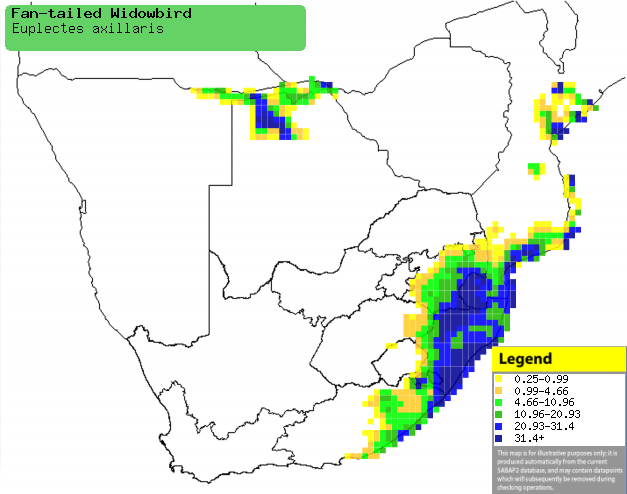|
Euplectes axillaris
(Fan-tailed widowbird, Red-shouldered widow)
Kortstertflap [Afrikaans];
Isahomba, Isakhomba (terms applied to Yellow bishop) [Xhosa]; iNtaka (also
applied to Red-collared widow), uMahube, uMangube [Zulu]; Enzunge (applied
to some of the bishops, widows and sparrows) [Kwangali];
Roodschouderwidavink [Dutch]; Euplecte à épaules orangées [French];
Stummelwida [German]; Viúva-de-espáduas-vermelhas [Portuguese]
Life
> Eukaryotes >
Opisthokonta
> Metazoa (animals) >
Bilateria >
Deuterostomia > Chordata >
Craniata > Vertebrata (vertebrates) > Gnathostomata (jawed
vertebrates) > Teleostomi (teleost fish) > Osteichthyes (bony fish) > Class:
Sarcopterygii (lobe-finned
fish) > Stegocephalia (terrestrial
vertebrates) > Tetrapoda
(four-legged vertebrates) > Reptiliomorpha > Amniota >
Reptilia (reptiles) >
Romeriida > Diapsida > Archosauromorpha > Archosauria >
Dinosauria
(dinosaurs) > Saurischia > Theropoda (bipedal predatory dinosaurs) >
Coelurosauria > Maniraptora > Aves
(birds) >
Order: Passeriformes > Family: Ploceidae
> Genus: Euplectes
Distribution and habitat
Although it occupies small patches in West Africa, the bulk
of its population occurs from Ethiopia through Tanzania, Zambia and Angola to
southern Africa. Here it is fairly common in northern Botswana and the Caprivi
Stip (Namibia), as well as from central Mozambique through to eastern and
south-eastern South Africa. It generally prefers tall, moist grassland, marshes
and cultivated areas (such as sugar cane fields), although in the Okavango Delta
it also occurs in reedbeds and Papyrus (Cyperus papyrus) swamps.
|
 |
|
Distribution of Fan-tailed widowbird in southern Africa,
based on statistical smoothing of the records from first SA Bird Atlas
Project (©
Animal Demography unit, University of
Cape Town; smoothing by Birgit Erni and Francesca Little). Colours range
from dark blue (most common) through to yellow (least common).
See here for the latest distribution
from the SABAP2. |
Food
It mainly eats grass seeds taken from the ground or
directly from plants, occasionally foraging for insects. The following food items have been recorded
in its diet:
- Grass seeds
- Digitaria velutina (Finger grass)
- Panicum maximum (Guinea grass)
- Paspalum dilatatum (Common paspalum)
- Echinochloa colona (Jungle rice)
- Insects
Breeding
- Polygynous solitary nester, as each male can mate with up to 4 females in
a breeding season, defending a territory with up to 8 nests against other
Euplectes species. It is thought the males with the largest and
brightest shoulders (actually known as epaulets) are the most successful at
setting up territories.
- The nest is built by the male and consists of an oval ball with a side
entrance, made of woven grass strips and lined by the female with grass seed
heads. It is typically placed in a clump of grass in marshy ground or in
rank vegetation between sugar cane fields.
- Egg-laying season is from October-March, peaking from November-January.
- It lay 2-3 eggs, which are incubated solely by the female for about
12-13 days.
- The chicks are fed by the female only, leaving the nest after about
15-16 days, and remaining dependent on their mother for food for about two
more weeks.
Threats
Not threatened.
References
-
Hockey PAR, Dean WRJ and Ryan PG 2005. Roberts
- Birds of southern Africa, VIIth ed. The Trustees of the John Voelcker
Bird Book Fund, Cape Town.
|
